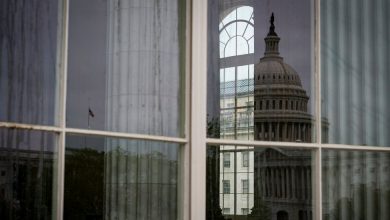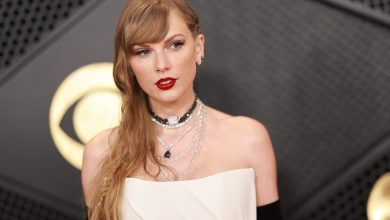Amid a Rise in Shootings, New York’s Children Confront a Wave of Grief

When the thick pall of a gunman’s smoke bombs cleared on the 36th Street subway platform on April 12, at least four of the people struck by bullets or injured in the ensuing panic were revealed to be children or teenagers.
Above ground, young people nearby and across Brooklyn rushed to take cover behind school walls, or anxiously waited as their parents hurried to retrieve them from street corners. Classrooms went on lockdown, shutting doors to visitors as students posted on windows messages of hope — and fear.
For many New York City children, the Sunset Park shooting was just the latest in a troubling series of violent acts in which young people have been wounded or killed. Two years of the pandemic worsened a mental-health crisis among the young; over the same period, shootings have risen sharply. Students, parents and teachers say that has exacted a deep toll on young people, both those who have taken bullets and those in their orbit who have watched the aftermath.
On April 12, as details of the Brooklyn shooting that injured 30 people were still emerging, a Bronx community 16 miles away was reeling from tragedy: a sunset memorial was planned for a 16-year-old who had been killed in a shooting after class.
The following afternoon, even as the police made an arrest in the subway attack, dozens of East Flatbush, Brooklyn, teenagers wept outside their middle school, K763 Brooklyn Science and Engineering, for a beloved friend recently killed.
“I find it really hard to admit that I’m in pain,” said Tatiana Barrett, 14, a student at the school and friend of the teenager who was killed. “As the days go by, I get angrier and angrier.”
The pandemic’s disruption and the upheaval it has inflicted on young people are well documented, from the classroom to home life. Medical groups declared an emergency in child and adolescent mental health last winter, a crisis exacerbated by isolation, uncertainty and grief. In New York City, more than one in every 200 children have lost a parent or caregiver to the virus, almost double the nationwide rate, a recent analysis found.
Some of the harm has been direct, physical and deadly: When shootings in New York rose after the virus struck, doubling from historic lows in 2018 and 2019, so did the number of young people caught in the violence.
At least 40 children and teenagers have been shot in 2022, making up about one in every 10 victims. The number is on track to match or exceed the number of youth victims last year, when 138 were struck by bullets.
The tallies remain significantly below those of decades ago: At least 530 children under 16 were shot in 1991 alone, for example, and 54 died. Still, the figures represent a significant rise from prepandemic years. Fewer than 65 minors were shot in both 2018 and 2019.
City officials have tried to quell the violence in several ways, including by targeting guns on city streets and expanding the youth summer jobs program to 100,000 positions. Some residents, meanwhile, have argued that the city needs a more intense focus on poverty and on scant resources in their neighborhoods.
This year, some of the highest-profile killings have had children as their victims. Some have been casualties of street disputes or long-running feuds. Others were hit by stray rounds in cars, parks or on sidewalks.
For Kyla-Simone Sobers Batties, 17, a calm senior year was interrupted on Oct. 1 when a stray bullet struck her in the head while she hung out with friends in Boerum Hill, Brooklyn. She spent two weeks in an induced coma and found a frustrating world awaiting, said her mother, Nadine Sobers.
The bullet missed Kyla-Simone’s brain, but she became forgetful, often asking the same questions three or four times. Her vision was so blurred she needed help walking to the restroom at night. She experienced near-constant pain. Meanwhile, classmates were celebrating the milestones of their final year.
“She had nightmares,” her mother said. “I would walk into her room and find her crying in her bed. This was a child who didn’t like having arguments — and now she would get angry easily, she was always upset.”
“She has tried to be resilient. But it will never be easy for her,” her mother added.
The trauma of some shootings has rippled beyond the young people who have cried over their classmates even to those who have watched the tragedies from afar — including the attack in Sunset Park, which unspooled as many students were passing through on their way to school.
Shahana Ghosh, a teacher at P.S. 24 in the neighborhood, said that in the days after, her first graders knew “someone had hurt a lot of people,” but they wrestled with why, and what they should do if in a similar situation.
“There was fear and anxiousness there. I could see it on their faces,” Ms. Ghosh said. “They were talking about the helicopters overhead, how that scared them through the night.”
Two blocks away, some teenagers at Sunset Park High School — whose doors are about 250 feet from the subway station — had “low-level panic attacks” that morning, said Dan Wever, an art teacher. He tried to keep them busy, leading them in a hands-on activity — and coaxing them away from the news on their phones, he said.
Many seemed to search for any sense of normality, he said, and “cut their brains off” from the scene outside the windows.
“The past two years have been just full of trauma,” Mr. Wever said. “With Covid and now this happening to our school, the students are put in a situation where I think years from now, this is going to keep affecting them.”
Experts have long warned of long-term setbacks in schooling and health for students exposed to gun violence. Aditi Vasan, a pediatrician at Children’s Hospital of Philadelphia, where gun violence reached all-time highs last year, said the ramifications could arrive much sooner.
Dr. Vasan and other researchers found that in the two weeks after a shooting, children living nearby were nearly twice as likely to visit emergency rooms for problems like anxiety, depression and self-harm.
“It has been striking to see how quickly these symptoms can arise,” she said. “A lot of these children are experiencing them really immediately and very frequently.”
The breadth of the challenges are evident across New York. Twenty-one children and teenagers were killed last year, more than double that number in 2020, leaving empty seats behind in their classrooms. A 3-year-old girl was hit in the shoulder in March while leaving a Brownsville, Brooklyn, day care center.
The following month, Angellyh Yambo, a 16-year-old in the Melrose neighborhood of the Bronx who aspired to become a model, was killed when she was struck by a stray bullet while walking home from school. Two other teenagers were shot but survived, including Isaiah Duncan, 17, who has told reporters that he has struggled to sleep since, having nightmares over the violence.
One week after the Bronx shootings, more than 150 students in East Flatbush — mostly young Black children between 12 and 14 years old — lifted candles to mourn another loss. Their seventh-grade classmate, Kade Lewin, 12, had been shot in the head in a case of mistaken identity.
At one point during the memorial, three girls in the back row rested their heads on one another’s right shoulders, taking deep breaths. Two boys in black hooded sweatshirts shared a 10-second embrace, wiping away tears.
Tatiana Barrett, the 14-year-old student at K763 Brooklyn Science and Engineering Academy, said in an interview that she has struggled to move forward after the shooting, taking several trips to the street where Kade’s family car had been parked, and to his mother’s house.
She has had trouble concentrating, describing herself as often “blurry-minded.” Her mother said that she has withdrawn, asking to spend more time alone.
Tatiana mourned Kade, whom she had known for four years, at his funeral on Wednesday. As for his burial the following day, she told her mother that “she couldn’t bear it.”
David Walcott Jr., a 12-year-old schoolmate, asked to stay home from memorials and the funeral, his father said. He has become anxious, worrying who could be the next victim. On one recent morning around 2 a.m., David was shaken up when a loud car passed by their home as he watched television and emitted a gunfire-like noise.
“Why do we live here?” his father, David Walcott, recalled his asking. “He said he’s starting to understand racism. He’s like, ‘It only happens in our neighborhoods that innocent people are dying.’”
The teenagers in East Flatbush released three turquoise balloons into the sky at the end of their memorial for Kade, filled with poems and writings. The wind carried one into a tree’s branches, where it lingered, a reminder of the persistent grief in the school nearby.
Kirsten Noyes contributed research.



